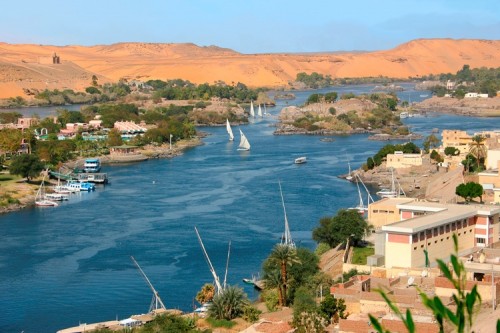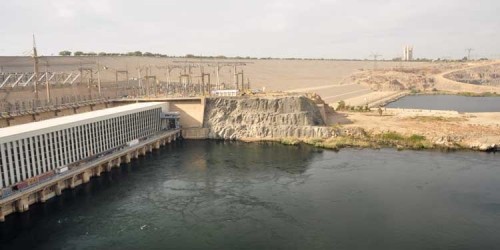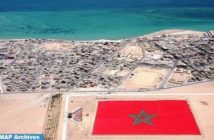Yesterday, Egypt, Ethiopia and Sudan signed a declaration of principles to resolve Nile dam dispute.
“For thousands of years, the Nile water has been flowing with God’s order,” El-Sisi told hundreds of Nile Basin delegates who gathered in the Sudanese capital of Khartoum for the announcement of a deal.
“We could cooperate and accomplish great things or disagree and hurt each other…we have chosen to cooperate,” El-Sisi told the audience to strong applause.
The Declaration of Principles stipulates that the three countries (Egypt, Ethiopia and Sudan) have committed themselves to the following principles concerning the Grand Ethiopian Renaissance Dam:
– Cooperation based on mutual understanding, common interest, good intentions, benefits for all, and the principles of international law.
– Cooperation in understanding the water needs of upstream and downstream countries across all their lands.
2. Principle of development, regional integration and sustainability:
The three countries will take all the necessary procedures to avoid causing significant damage while using the Blue Nile (the Nile’s main river).
– In spite of that, in case significant damage is caused to one of these countries, the country causing the damage […], in the absence of an agreement over that [damaging]action, [is to take]all the necessary procedures to alleviate this damage, and discuss compensation whenever convenient.
The three countries will use their common water sources in their provinces in a fair and appropriate manner.
The Nile
The Nile, the Cradle of civilizations, as long as 6,853 km, longer than the distance from Helsinki to Khartoum (5005 km). The Nile has been the lifeline of civilization in Egypt since the Stone Age, with most of the population and all of the cities of Egypt resting along those parts of the Nile valley lying north of Aswan.
The Nile, as a sword of life, succeeded to cross the huge dry and hot Sahara until it reached the Mediterranean sea, connecting the heart of Africa toEurope.
The Nile, which gives to the Egyptians fresh water without being able to watch or to feel one single drop of rain, taking them to the myth to be able to understand from where comes all this water. Is the Nile a main reason behind the Ancient Egyptian spirituality? One of the Egyptians gods, Hapy was the god of the annual floods, and both he and the pharaoh were thought to control the flooding.
The Nile, an “international” river as its water resources are shared by eleven countries and the most important is Ethiopia who decided to build a dam on one of its main sources.
The Nile, which could be an excellent opportunity of cooperation between African countries or a terrible occasion to start wars and fights to get the water, one of the oldest reasons of war in the human beings history.
Which way will we take?
The land of Punt
The land of Punt, most probably coastal region of what is today Somalia, Djibouti, Eritrea, Northeast Ethiopia and the Red Sea coast of Sudan, was a maritime trade partner to Egypt. The Egyptians reached these territories by crossing the Red Sea and not the Nile.A tree in front of Hatshepsut’s temple, claimed to have been brought from Punt by Hatshepsut’s Expedition which is depicted on the Temple walls.
The temple illustrates expedition of Hatshepsut occurred in Year 9 of the female pharaoh’s reign with the blessing of the god Amun: Said by Amen, the Lord of the Thrones of the Two Land: ‘Come, come in peace my daughter, the graceful, who art in my heart, King Maatkare [ie. Hatshepsut]…I will give thee Punt, the whole of it…I will lead your soldiers by land and by water, on mysterious shores, which join the harbours of incense…They will take incense as much as they like. They will load their ships to the satisfaction of their hearts with trees of green [ie. fresh] incense, and all the good things of the land.’
L’Egitto, l’Etiopia e il Sudan hanno firmato una dichiarazione di intenti per risolvere la questione della diga sul Nilo. “Per migliaia di anni, il corso delle acque del fiume ha seguito il suo flusso secondo l’ordine di Dio”, ha detto il presidente egiziano al-Sisi rivolgendosi alle centinaia di delegati delle terre del bacino che si sono riuniti a Kartoum, capitale del Sudan, in occasione dell’annuncio dell’accordo. “Dinanzi a noi due scelte: cooperare e fare grandi cose insieme o metterci l’uno contro l’altro…noi abbiamo scelto di cooperare”, ha aggiunto al-Sisi conquistandosi un forte applauso dalla platea. La dichiarazione stabilisce che i tre paesi – Egitto, Etiopia e Sudan- si impegnino a osservare i seguenti principi riguardo alla Diga della Grande Rinascita Etiopica:
1) cooperazione basata su mutua comprensione, interesse comune, buone intenzioni, vantaggi per tutti, rispetto delle regole internazionali; cooperazione anche nel comprendere i bisogni di acqua dei paesi che stanno a monte delle sorgenti e di quelli che si trovano al si sotto; 2) sviluppo, integrazione regionale e sostenibilità. I tre paese avvieranno le necessarie procedure per evitare di causare danni significativi mentre verranno utilizzate le acque del Nilo Blu. Se questo, nonostante tutto dovesse accadere per responsabilità di uno dei paesi firmatari dell’accordo, il paese che avrà provocato il danno, in mancanza di regole condivise, dovrà mettere in campo tutte le misure possibili per contenerne gli effetti e discutere l’entità dell’eventuale risarcimento. I tre paesi useranno le loro sorgenti comuni nelle loro province in maniera trasparente e appropriata.
Il Nilo
Il Nilo, culla di civiltà, si snoda per 6.853 km ed è più lungo della distanza da Helsinki a Khartoum, che è di 5050 km. E’ fonte di vita dall’età della pietra e lungo le sue rive si sono stabilite molte popolazioni e numorse città dell’Egitto sono sorte nella valle che si estende a nord di Aswan. Il Nilo, come una spada di vita, è riuscito ad attraversare il grande Sahara secco e caldo fino a raggiungere il mare Mediterraneo, collegando il cuore dell’Africa all’Europa. Il fiume garantisce
acqua fresca senza nutrirsi di una singola goccia di pioggia e discende da ciò il mito delle origini di questo bene prezioso. Non è forse proprio esso la pricipale ragione dell’antica spiritualtà egiziana? Una delle divinità egiziane, Api, era il dio delle inondazioni. Api insieme al faraone, si riteneva che controllasse la piena. Il Nilo è un fiume internazione poiché le sue sorgenti sono comuni a 11 paesi, e il più importante è l’Etiopia che ha deciso di costruire una diga su una delle sue principali sorgenti. Il Nilo potrebbe essere un’eccellente opportunità di cooperazione tra i paesi africani ma anche una terribile occasione per l’inizio di guerre e battaglie per il controllo dell’acqua, una delle più antiche cause di conflitto nella storia dell’umanità. Che via imboccheremo?
La terra di Punt
La terra di Punt, molto probabilmente la regione costiera di ciò che oggi è diviso tra Somalia, Gibuti, Eritrea, Nordest dell’Etiopia e la parte del Sudan bagnata dal mar Rosso, era un partner commerciale marittimo dell’Egitto. Gli egiziani raggiungevano quel territorio attraversando il Mar Rosso e non il Nilo. L’albero che si trova dinanzi al tempio di Hatshepsut si ritiene sia stato portato da Punt durante la spedizione di Hatshepsut, che è raffigurata negli affreschi del tempio. Il tempio illustra la spedizione avvenuta nel nono anno del regno della faraona con la benedizione del dio Amun.
E’ stato detto da Amun, il signore dei troni delle due terre: “Viene, vieni in pace, figlia mia, grazia che riempie il mio cuore, re Maatkare…Io ti darò Punt, per intero. Guiderò i soldati per terra e per mare sulle misteriose spiagge che collegano i porti di incenso…Loro prenderanno l’incenso quanto ne vorranno. Riempiranno le loro navi per soddisfare i loro cuori di alberi di verde incenso e di tutte le cose buone della terra”.
Paul Attallah






